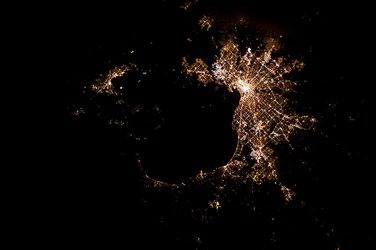Astronaut photography benefiting the planet
When astronauts take photographs of our planet while orbiting 400 km above our heads, they are doing much more than just taking pretty pictures. They are looking after the health of our planet and, ultimately, us too.
Techniques used by astrophotographers looking at the stars and space exploration come together to measure the environmental impact of artificial lights at night.
The only night images of Earth in colour that are freely available to the public are pictures taken by the astronauts from the International Space Station, and a few colour composites made by ESA’s Rosetta satellite. NASA has a public database with over 1.3 million colour photographs taken by astronauts since 2003.

Now researchers are looking at these nocturnal images in a different light. A team of scientists came up with a method to classify outdoor lighting using colour diagrams and calibration techniques. The resulting spectral information, such as colour temperature, is a useful tool to assess the environmental impact of artificial light.
“We hope to take photography from the Space Station to a new level,” says Alejandro Sánchez de Miguel, a research fellow at the UK’s University of Exeter and lead investigator of the Cities at night project that raises awareness of light pollution.
Human vision from space
City lights are disruptive not only for the lives of nocturnal animals, who suffer from disorientation and behavioural and physiological changes, but also for people. An excess of artificial light before bedtime reduces melatonin production, a hormone linked to sleep. This suppression can lead to negative effects on our health, including breast and prostate cancer.
In addition, streetlights account for a large chunk of a country’s energy consumption.

“This is not only about being able to see the stars,” says Alejandro. “All living creatures on our planet, including us humans, suffer from artificial nighttime lighting. And only the humans living off planet Earth can help us.”
Scientists use synthetic photometry to analyse the images, a mathematical technique that can help identify light sources under different light conditions and camera settings. The results give precise information about how colour and brightness of street lamps can suppress melatonin production or obstruct the vision of the stars.
Citizen science
Milan is a perfect case study for this research. This Italian city replaced its orange sodium lamps with white LED lamps. The study proves that the whiter light sources are worse for the local environment.
“We provide a basis for creating risk maps of artificial lightning. Governments could use this information to reduce light pollution,” says Alejandro.
The next step is to open the door to citizen science. A future paper will show how to use any camera to capture light at home and analyse whether the light bulb is conducive to optimal sleep patterns.















 Germany
Germany
 Austria
Austria
 Belgium
Belgium
 Denmark
Denmark
 Spain
Spain
 Estonia
Estonia
 Finland
Finland
 France
France
 Greece
Greece
 Hungary
Hungary
 Ireland
Ireland
 Italy
Italy
 Luxembourg
Luxembourg
 Norway
Norway
 The Netherlands
The Netherlands
 Poland
Poland
 Portugal
Portugal
 Czechia
Czechia
 Romania
Romania
 United Kingdom
United Kingdom
 Slovenia
Slovenia
 Sweden
Sweden
 Switzerland
Switzerland


































